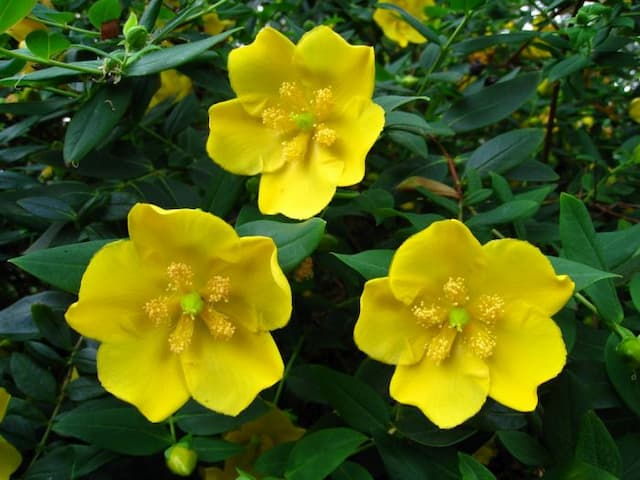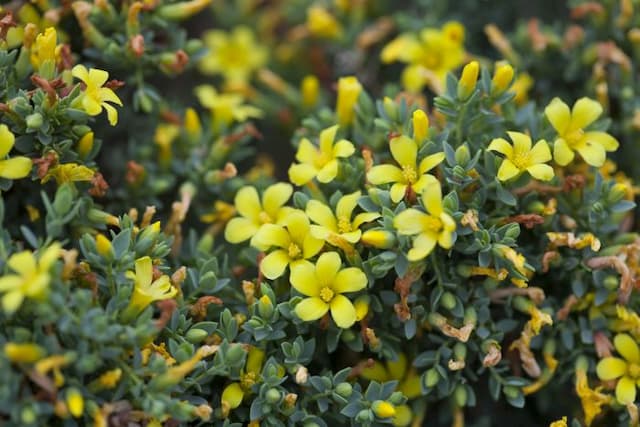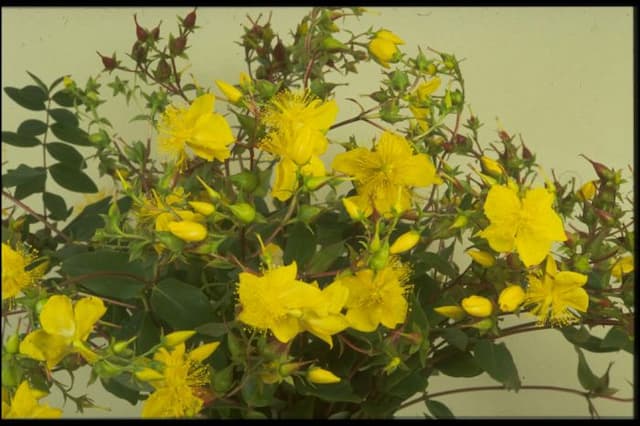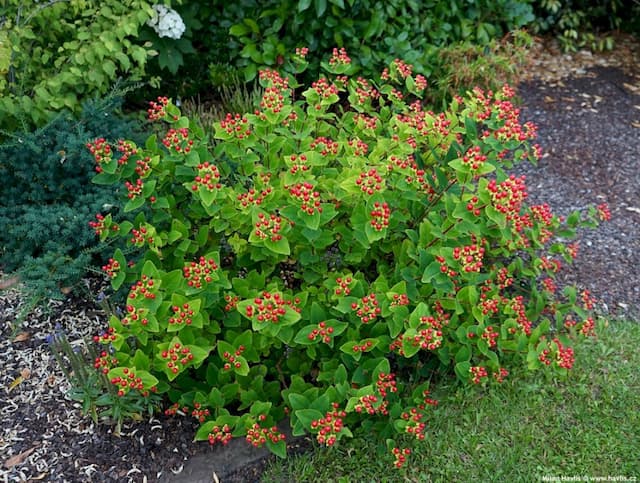Lancaster St. John's Wort Hypericum lancasteri

ABOUT
Hypericum lancasteri, commonly known as Lancaster St. John's Wort, features a robust and bushy appearance. This plant is characterized by an abundance of bright yellow flowers, which have a distinctive, almost sun-like shape, with several elongated, fine petals surrounding a central, prominent tuft of stamens. Flowers form in clusters, creating a dramatic and eye-catching display when in bloom. The leaves of Lancaster St. John's Wort are typically a deep, glossy green, and they possess a simple, oblong to elliptical shape with smooth edges. They are arranged in an opposite pattern along the branches, which creates a pleasing symmetry and visual texture to the plant's overall appearance. The stems are numerous and upright, supporting the floriferous nature of this plant, and they may exhibit a reddish tinge especially near the tips where the younger growth is present. When bruised or cut, the stems and leaves may exude a reddish or clear sap. While flowering, Lancaster St. John's Wort provides a lush, vibrant presence in the garden, and its foliage offers a continual display of greenery throughout the growing season. The contrast between the bright flowers and dark foliage makes it particularly attractive in landscape settings where it is used as an ornamental plant. Its dense growth habit makes it a popular choice for borders or as a foundational plant in garden designs.
About this plant
 Names
NamesFamily
Hypericaceae
Synonyms
Lancaster St. John's Wort
Common names
Hypericum lancasteri.
 Toxicity
ToxicityTo humans
Hypericum lancasteri, commonly known as Lancaster St. John's Wort, does not have a well-documented profile of toxicity to humans. However, plants in the Hypericum genus are known for containing hypericin, which can be toxic in large quantities. If ingested, it may cause gastrointestinal disturbances such as nausea, vomiting, and diarrhea. Sensitivity to sunlight, also known as photodermatitis, could occur with substantial exposure to the plant. It is always advisable to exercise caution and avoid ingesting parts of plants that are not commonly used as food, as individual reactions can vary.
To pets
Lancaster St. John's Wort is not well known for being toxic to pets. However, as with its potential effects on humans, plants in the Hypericum genus can contain hypericin, which may lead to photosensitization in animals when consumed in significant quantities. Photosensitization can result in skin irritation and inflammation when exposed to sunlight. Additionally, if a pet consumes a large amount of this plant, gastrointestinal upset could occur. Signs of poisoning could include vomiting, diarrhea, and lethargy. If you suspect your pet has ingested this plant, it is recommended to consult a veterinarian.
 Characteristics
CharacteristicsLife cycle
Perennials
Foliage type
Deciduous
Color of leaves
Green
Flower color
Yellow
Height
1-3 feet (30-90 cm)
Spread
1-2 feet (30-60 cm)
Plant type
Shrub
Hardiness zones
5
Native area
China
Benefits
 General Benefits
General Benefits- Ornamental Value: Hypericum lancasteri, commonly known as Lancaster St. John's Wort, offers bright yellow flowers that can enhance the aesthetic appeal of gardens and landscapes.
- Low Maintenance: This plant is known for being hardy and requiring minimal care once established, making it suitable for gardeners of all skill levels.
- Drought Tolerance: Lancaster St. John's Wort is relatively drought-tolerant, making it an excellent choice for xeriscaping and water-efficient landscaping.
- Attracts Pollinators: The flowers of Hypericum lancasteri attract bees and other beneficial pollinators, supporting local ecosystems and biodiversity.
- Erosion Control: With its dense growth habit, it can be used to stabilize soil and prevent erosion on slopes and banks.
- Wildlife Habitat: The dense foliage provides shelter for small animals and birds, enhancing wildlife habitat in the area.
- Adaptability: Lancaster St. John's Wort can adapt to a variety of soil types, though it prefers well-drained conditions, making it versatile for different garden settings.
- Seasonal Interest: Apart from its summer flowering period, this plant may also provide interesting seed pods and autumnal color, offering multi-seasonal interest in the landscape.
 Medical Properties
Medical PropertiesThis plant is not used for medical purposes.
 Air-purifying Qualities
Air-purifying QualitiesThis plant is not specifically known for air purifying qualities.
 Other Uses
Other Uses- Ornamental purposes: Hypericum lancasteri, more commonly known as Lancaster St. John's Wort, can be grown for its attractive foliage and bright yellow flowers which can enhance the aesthetic appeal of gardens and landscapes.
- Natural dye: The vibrant yellow flowers of Lancaster St. John's Wort can be used to produce a natural dye for coloring textiles and other materials.
- Photography: Due to its striking appearance when in bloom, Lancaster St. John's Wort can serve as an excellent subject for nature photography and botanical illustration.
- Habitat creation: The plant can be used to create and enhance habitats for insects, providing a food source for bees and butterflies with its nectar-rich flowers.
- Erosion control: Lancaster St. John's Wort can be implemented in soil stabilization projects on slopes and banks to help prevent erosion due to its root structure.
- Craft projects: Dried flowers and stems of Lancaster St. John's Wort can be incorporated into craft projects like wreaths, floral arrangements, and potpourri mixtures.
- Education: The plant can be grown by schools and educational institutions as part of botany curriculum to study plant growth, pollination, and lifecycle.
- Border planting: Because of its medium height and dense growth, Lancaster St. John's Wort is suitable for border planting in gardens and parks.
- Companion planting: The plant can be used in companion planting strategies to attract beneficial insects which in turn can help with pest control in the garden.
- Sensory garden inclusion: With its bright flowers and textured leaves, this species can be included in sensory gardens designed for educational and therapeutic purposes.
Interesting Facts
 Feng Shui
Feng ShuiThe plant St. John's Wort is not used in Feng Shui practice.
 Zodiac Sign Compitability
Zodiac Sign CompitabilityThe plant St. John's Wort is not used in astrology practice.
 Plant Symbolism
Plant Symbolism- Protection: Hypericum, commonly known as St. John's Wort, is often associated with warding off negative influences and protecting against evil spirits. It has been used in folklore for spiritual protection.
- Healing: St. John's Wort is renowned for its medicinal properties, especially in treating depression and promoting overall mental health.
- Strength: Due to its resilience and hardiness, St. John's Wort represents strength and the ability to overcome challenges.
- Love and Happiness: The bright yellow flowers of St. John's Wort are connected with joy, love, and the lightness of being, often used to dispel sadness.
- Midsummer Celebrations: Traditionally, St. John's Wort is associated with St. John's Day and Midsummer festivals, symbolizing the peak of summer's warmth and light.
 Water
WaterSt. John's Wort prefers consistent moisture but is drought tolerant once established. It should be watered deeply once a week, providing about 1 to 1.5 gallons of water for each plant. The soil should be allowed to dry out slightly between waterings. During hot and dry periods, water twice a week to prevent stress. Do not overwater, as this may lead to root rot.
 Light
LightSt. John's Wort thrives in full sun to partial shade. It performs best with at least six hours of direct sunlight daily, but can tolerate some afternoon shade. The ideal spot would be one that enjoys morning sun and dappled light in the later part of the day.
 Temperature
TemperatureSt. John's Wort can tolerate a wide range of temperatures but prefers a moderate climate. The ideal temperature range for this plant is between 60°F and 70°F. However, it can survive in temperatures as low as 0°F and as high as 80°F, but extreme temperatures may cause stress to the plant.
 Pruning
PruningSt. John's Wort should be pruned to encourage bushy growth and to maintain its shape. Prune lightly in early spring before new growth begins. Deadheading spent blooms throughout the season can also promote additional flowering. Pruning can be done annually or as needed to remove dead or damaged branches.
 Cleaning
CleaningAs needed
 Soil
SoilLancaster St. John's Wort prefers well-draining soil with a pH between 5.5 and 7. A mix of loam, peat, and sand is ideal to provide adequate drainage and aeration. Ensuring organic matter is incorporated can also benefit plant health and growth.
 Repotting
RepottingLancaster St. John's Wort should be repotted every 2-3 years to replenish the soil nutrients and to accommodate growing roots. Use a slightly larger pot each time to allow for growth.
 Humidity & Misting
Humidity & MistingLancaster St. John's Wort thrives in moderate humidity levels, generally around 40-50%. It can tolerate some variation but consistently high humidity should be avoided to prevent issues like fungal diseases.
 Suitable locations
Suitable locationsIndoor
Place in bright, indirect light and keep soil moist.
Outdoor
Full sun to partial shade; well-drained soil; shelter from wind.
Hardiness zone
5-9 USDA
 Life cycle
Life cycleHypericum lancasteri, commonly known as Lancaster St. John's Wort, undergoes a typical angiosperm life cycle starting with seed germination, where the plant emerges from its dormant state upon favorable environmental conditions. The next stage is vegetative growth, where the plant develops roots, stems, and leaves, drawing nutrients and energy from the soil and sunlight to grow. Following vegetative growth, the plant enters the reproductive stage, producing flowers that attract pollinators for sexual reproduction. After successful pollination, the flowers produce fruits containing seeds, which, upon maturity, are dispersed into the environment. Finally, with the onset of unfavorable conditions such as the colder months or periods of drought, the plant may enter dormancy, ceasing active growth and conserving resources until conditions improve.
 Propogation
PropogationPropogation time
Spring to Summer
The most popular method of propagating Hypericum lancasteri, commonly known as Lancaster St. John's Wort, is through softwood cuttings. This technique is usually carried out in late spring or early summer when the plant's new growth is just beginning to harden but is still flexible. To propagate, gardeners select a healthy stem with new growth and cut a 4 to 6 inch (approximately 10 to 15 cm) section just below a leaf node. The lower leaves are removed, and the cutting is dipped in rooting hormone powder to encourage root development. Finally, the prepared cutting is placed in a well-draining potting mix, ensuring at least one node is buried where roots can form. The pot is then kept in a warm environment with high humidity, maintaining moist soil until roots establish, after which the new plant can be gradually acclimated to ambient conditions before transplanting.









